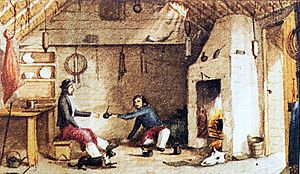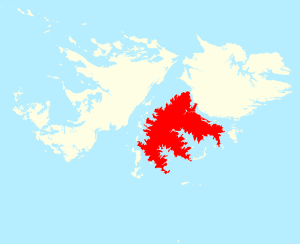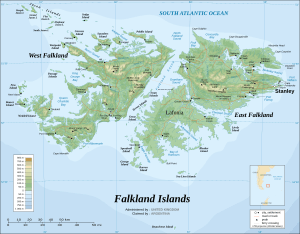Lafonia facts for kids
Lafonia is a large peninsula that makes up the southern part of East Falkland. East Falkland is the biggest island in the Falkland Islands.
Geography and Land Features
Lafonia looks a bit like the letter "E" from above. It connects to the northern part of East Falkland by a narrow strip of land called an isthmus. This strip is about 2.5 kilometers (1.5 miles) wide. If this narrow strip were ever cut off, Lafonia would become the third largest island in the Falklands!
To the west of Lafonia is a body of water called Falkland Sound. This sound separates Lafonia from West Falkland. Another body of water, Choiseul Sound, divides Lafonia from the northern part of East Falkland.
Several smaller islands are located near Lafonia. These include Barren Island, Bleaker Island, George Island, Lively Island, Sea Lion Island, and Speedwell Island.
The land in Lafonia is mostly flat and low. Its rocks are very old, from a time called the Permian period. These rocks are made of sandy sediments. Sometimes, cracks in these rocks were filled with a type of volcanic rock called basalt. In recent years, people have even looked for gold in Lafonia!
History and People

Lafonia is a quiet place with very few people living there. Most of its settlements were built in the mid-1800s.
In 1845, a rich merchant named Mr. Samuel Fisher Lafone bought the southern part of East Falkland. This area, which became known as Lafonia, was huge – about 600,000 acres (2,400 square kilometers)! He also got the right to all the wild cattle on the island for six years. He paid £10,000 upfront and agreed to pay another £20,000 later.
In 1851, a company called the Falkland Islands Company bought Mr. Lafone's share of Lafonia for £30,000. This company was formed in the same year.
Since the early 1800s, Lafonia has been used for sheep farming. The main farming operations are run from Darwin (founded in 1859) and Goose Green. Both of these places are on the narrow strip of land connecting Lafonia to the rest of East Falkland.
The only other main settlement in Lafonia itself is North Arm Settlement. There's also a smaller place called Walker Creek.
One interesting spot is the Bodie Suspension Bridge, built in 1925. People say it's the southernmost suspension bridge in the world! You can also find a shop there. Some historic buildings in Lafonia include The Galpon and Stone Corral in Darwin, and The Stone Cottage and Goose Green Hall in Goose Green.
During the Falklands War in 1982, some of the first land battles happened in Lafonia, especially near Goose Green. Many soldiers were stationed there, and about a hundred local people were kept in the community hall for safety. Today, there is an Argentine Military Cemetery in the area. Some parts of Lafonia, especially near Darwin and Goose Green, still have hidden landmines from the war.
Other small settlements in Lafonia include Port King and Egg Harbour. There's also an abandoned place called Hope Place.
Wildlife and Nature
The famous scientist Charles Darwin explored Lafonia's wildlife during his journey on HMS Beagle.
Lafonia is home to several types of birds, including the Chiloé wigeon, silver teal, and yellow-billed pintail. You can also find brown trout in some streams that flow into Choiseul Sound. Another type of fish, called zebra trout, also lives here.
See also
 In Spanish: Lafonia para niños
In Spanish: Lafonia para niños



